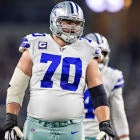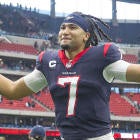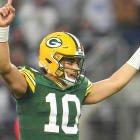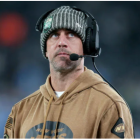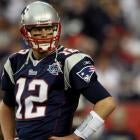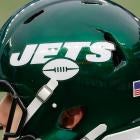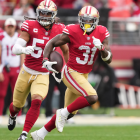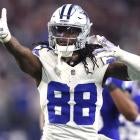Running backs might not matter in the modern NFL, but that doesn't mean running backs aren't worthy of attention and praise. At a time when most teams are slowly figuring out (some more slowly than others) that wasting high draft picks or shelling out money on running backs in free agency isn't prudent from a team-building sense, the NFL has also been blessed with an abundance of running back talent that has enhanced the quality of the game.
All eight divisions contain a wealth of running back depth, which made ranking the eight divisions by running backs especially difficult, which is what I did in this story. As the offseason churns along, we've shifted our attention away from ranking the divisions by quarterbacks to ranking the divisions by running backs.
Like our quarterback rankings, ordering the eight divisions based on their running backs wasn't easy. Tough decisions had to be made. It might seem unfair for the NFC West -- with Todd Gurley and David Johnson -- to be ranked fifth, but that doesn't mean the NFC West is a bad division in terms of its running backs. It just means the four divisions ranked ahead of the NFC West project to be slightly better during the upcoming season.
Before we get to the rankings, a couple of notes:
- Balance matters. It's not just about star power. It's also about every division's worst running back situation. All four backfields per division matter. So does depth in each team's backfield. The Patriots are a great example of this. They might not have a star running back, but they have three or four running backs who can combine to accomplish what they need to get done. Plus, unlike a few teams that each have a superstar RB1, the Patriots have tremendous depth at the position. They can survive an injury more easily than other teams. That's why balance matters.
- Pass-catching ability matters. That's why you'll see yards from scrimmage cited more than rushing yards.
With that, we begin with the AFC South.
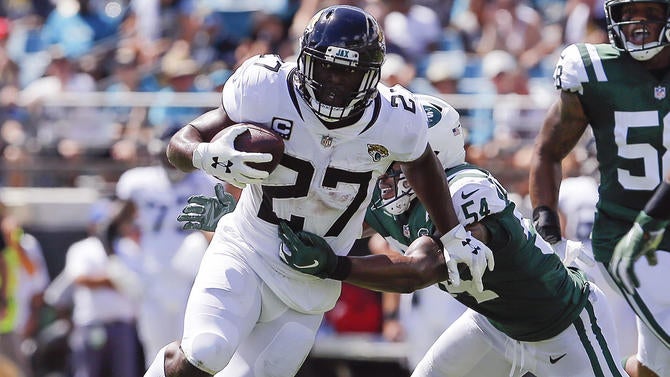
8. AFC South
Colts: Marlon Mack, Nyheim Hines
Jaguars: Leonard Fournette, Alfred Blue, Thomas Rawls
Texans: Lamar Miller, D'Onta Foreman
Titans: Derrick Henry, Dion Lewis
Leonard Fournette is the perfect example of why teams should never draft running backs early in the first round. The Jaguars took Fournette fourth overall in 2017 when players like Patrick Mahomes, Deshaun Watson, Marshon Lattimore, and Jamal Adams were still available. Heck, if they really felt like they had to take a running back, they could've went with Christian McCaffrey. Instead, the Jaguars took a running back who is averaging 3.7 yards per carry and has missed 11 games during his first two seasons.
The Colts, Texans, and Titans all own better backfields than the Jaguars. Marlon Mack has the best chance to emerge as a star in 2019 after racking up 1,011 yards and 10 touchdowns from scrimmage in a 12-game season. Lamar Miller has been consistent for a while now with five straight 1,000-yard seasons (from scrimmage). Derrick Henry is coming off the best season of his career while Dion Lewis is a worthwhile sidekick.
What the AFC South is lacking in is star power. That could change during the upcoming season if Mack and Henry continue their ascent, but neither of those ascents should be regarded as a sure thing.
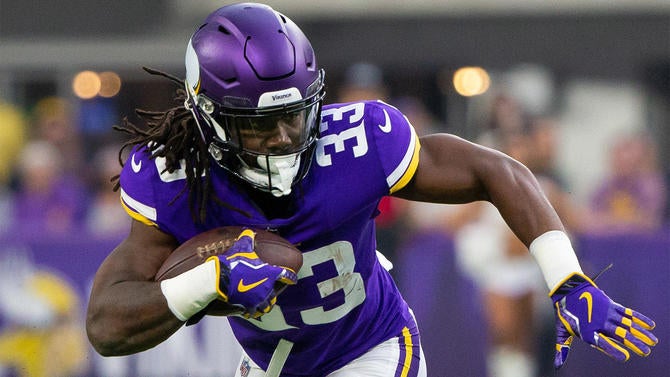
7. NFC North
Bears: Tarik Cohen, David Montgomery, Mike Davis
Lions: Kerryon Johnson, Theo Riddick, C.J. Anderson, Zach Zenner
Packers: Aaron Jones, Jamaal Williams, Dexter Williams
Vikings: Dalvin Cook, Alexander Mattison, Ameer Abdullah
The NFC North's group of running backs is talented across the board, but there are consistency issues.
Tarik Cohen is as dynamic as any other playmaker, but probably can't shoulder a full RB1 workload. The Bears did add David Montgomery in the draft and Mike Davis in free agency, which gives them the deepest backfield in the division if Montgomery meets expectations as a rookie and Davis builds off his career-best season with the Seahawks (4.6 yards per carry). Aaron Jones appears to be on the cusp of a major breakout in Green Bay after he put up 934 yards and nine touchdowns from scrimmage in a 12-game season, but he hasn't completely broken out yet.
Dalvin Cook's talent is undeniable, but injuries have limited him to only 15 games over the past two seasons. As a result, he's totaled only 1,364 yards and six touchdowns from scrimmage in in his career. He has promise, but he's yet to cash in on it. Third-round rookie Alexander Mattison gives the Vikings another option if Cook's injury woes persist, but like most rookies, it's impossible to know ahead of time how Mattison will fare at the next level.
Like every other backfield in the division, the Lions' holds plenty of promise. Before landing on injured reserve, Kerryon Johnson exploded for 854 yards from scrimmage in 10 games. If he can piece together a full second season, he could end up becoming the division's best running back.
The NFC North has a promising group of running backs, but none of them -- outside of Cohen -- have made it yet, which is why the division is both ranked low and is also a strong candidate to make a sizable jump up the list a year from now. I see more breakout potential in the NFC North than I do in the AFC South.
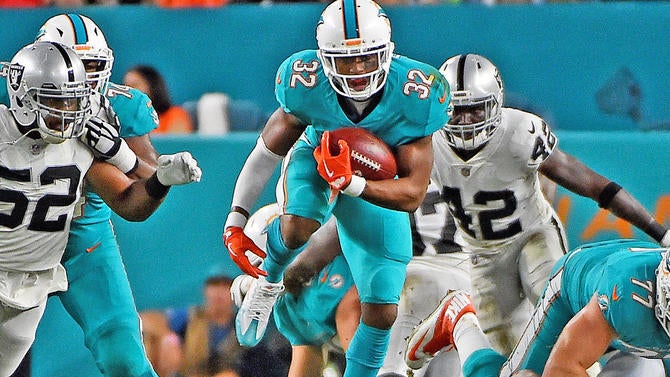
6. AFC East
Bills: LeSean McCoy, Frank Gore, T.J. Yeldon, Devin Singletary
Dolphins: Kenyan Drake, Kalen Ballage, Myles Gaskin
Jets: Le'Veon Bell, Elijah McGuire
Patriots: Sony Michel, James White, Rex Burkhead, Damien Harris
The Patriots get the job done without a star, but with a committee of running backs. Sony Michel is their primary ball carrier, James White is the perfect pass-catching back for Tom Brady, Rex Burkhead is great as a sidekick, and rookie Damien Harris should be a contributor. However, it's worth noting that Michel recently had a knee scope. He's expected to be back by training camp, but Michel has a history of knee injuries. So, it's a concern.
Meanwhile, the Jets signed Le'Veon Bell, arguably the best running back in football. Bell alone is enough to turn the Jets' backfield into a real asset.
The rest of the division is interesting, because it's difficult to predict how they'll fare during the upcoming season.
Just a year ago, LeSean McCoy was regarded as one of the best players at his position group. But he proceeded to rush for 514 yards while averaging only 3.2 yards per carry. Was that because of his age (30)? Or was it due to the fact that he was playing alongside a quarterback who couldn't throw the ball with any sort of consistency and behind an offensive line that ranked 30th in run blocking by Football Outsiders' metrics? I'm willing to bet we'll see an improved version of McCoy after the Bills upgraded the offensive line this offseason, but he's unlikely to reach the peaks he hit earlier in his career. The rest of the Bills' backfield is solid. Frank Gore, who somehow keeps churning out yards, should make for a good backup.
Finally, there's Kenyan Drake, a breakout candidate for a second consecutive year. He's coming off a 1,012-yard, nine-touchdown season. If he takes the next step, he could become one of the best dual threat running backs in the sport. He caught 53 passes last year.
The AFC East is pretty well balanced. It's got a superstar in Bell, two former superstars in McCoy and Gore, a deep backfield in New England, and a breakout candidate in Drake. The fact that it's ranked sixth is a testament to how good the running back talent is across the league and how even it is in its distribution.
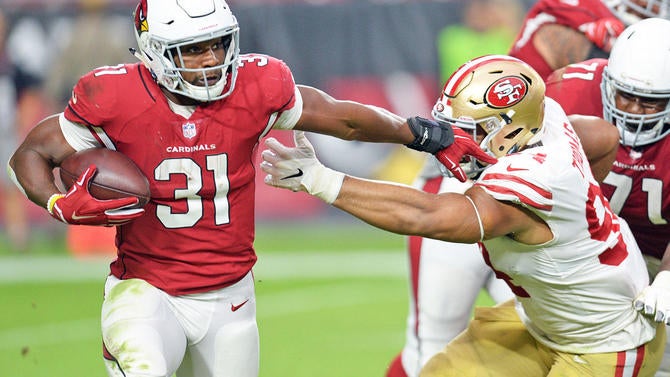
5. NFC West
49ers: Tevin Coleman, Jerick McKinnon, Matt Breida
Cardinals: David Johnson, Chase Edmonds
Rams: Todd Gurley, Malcolm Brown, Darrell Henderson
Seahawks: Chris Carson, Rashaad Penny
How quickly circumstances can change in the NFL. A year ago, Todd Gurley was the best running back in football. Two years ago, David Johnson was the best running back in football. Now, the division with both Gurley and Johnson is ranked in the bottom half.
It's not that Gurley and Johnson are bad. They're not. It's just that there are some concerns about both of them.
For Gurley, it's his knee injury, which limited him down the stretch last season and is expected to remain an issue during the upcoming season. Knee problems are problematic for any football player regardless of what position they play. It's especially troubling for a running back.
As for Johnson, he's yet to reach the peaks he hit during the 2016 season, when he totaled 2,118 yards and 20 touchdowns from scrimmage. He entered the 2017 season talking about how he wanted to cross the 1,000-yard threshold as a runner and receiver. At the time, his goal didn't seem at all unrealistic. It never happened, though. In 2017, he suffered a season-ending injury in Week 1. Last year, he was stuck in a horrific offense that refused to harness his strengths. He failed to reach 1,000 yards in either category. Johnson is a strong rebound candidate now that the Cardinals have hired a coach who appears to know how to run a functional offense, but his stock is lower than it's ever been.
Meanwhile, the 49ers have a nice trio of running backs, but none of them are stars. This list doesn't factor in contracts, but it's worth noting the 49ers have probably overpaid in free agency for two of their running backs. It might've been expensive, but they did at least assemble a very deep group that should shine in Kyle Shanahan's offense.
The Seahawks also could have a strong combination if Rashaad Penny lives up to expectations in Year 2. But a lot of their running success last year was about volume. They'd be wise to let Russell Wilson throw more than he did last year. He's the strength of their team.
All of this is just a long-winded way of saying the NFC West is a strong division in terms of its running backs, but it's not what it once was.
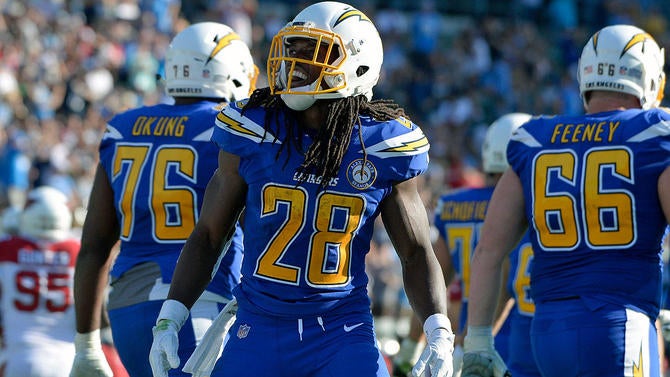
4. AFC West
Broncos: Phillip Lindsay, Royce Freeman, Devontae Booker
Chargers: Melvin Gordon, Austin Ekeler, Justin Jackson
Chiefs: Damien Williams, Carlos Hyde, Darwin Thompson
Raiders: Josh Jacobs, Jalen Richard, DeAndre Washington
The AFC West, like the remaining three divisions and the two divisions ranked just behind it, is stacked at the running back position. It's telling that the Chiefs, a team that figures to use its running backs in a variety of dazzling ways, likely have the worst backfield.
The Chargers have one of the best backfields in football with Melvin Gordon, Austin Ekeler, and Justin Jackson. Gordon will do the heavy lifting, but if he were to go down with an injury, the Chargers would be well-equipped to handle his absence. The Broncos have one of the most underrated trios in Phillip Lindsay, Royce Freeman, and Devontae Booker, who combined for 2,329 yards on 443 touches for an average of 5.3 yards per touch. The Raiders should improve as a running team after adding rookie Josh Jacobs -- the best running back prospect in the draft. The Chiefs might be lacking in top-tier talent after releasing Kareem Hunt, but there's no doubt Andy Reid's offense will get numbers out of the group. After emerging as the starter late last season, Damien Williams averaged 114.4 yards from scrimmage per game in three regular-season contest and two playoff starts.
The AFC West has a superstar (Gordon), a player on the cusp of stardom (Lindsay), a rookie worthy of hype (Jacobs), and a balanced backfield (Kansas City) that is good enough to put up big numbers in an awesome offense.
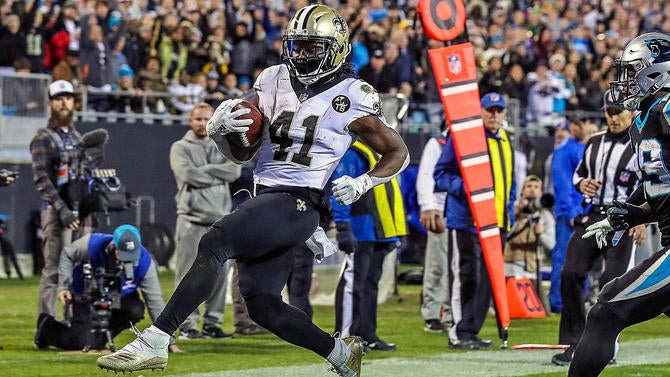
3. NFC South
Buccaneers: Peyton Barber, Ronald Jones
Falcons: Devonta Freeman, Ito Smith, Qadree Ollison
Panthers: Christian McCaffrey, Cameron Artis-Payne, Jordan Scarlett
Saints: Alvin Kamara, Latavius Murray
This is all about Christian McCaffrey and Alvin Kamara powering the NFC South to the No. 3 spot. They're two of the best running backs in football and they should continue to be two of the best running backs in football during the upcoming season. They're good enough to overcome the Buccaneers' running back situation.
The Buccaneers have one of the worst running back groups in football. It's a testament to McCaffrey and Kamara's greatness that the NFC South somehow overcame Tampa Bay's backfield duo of Peyton Barber and Ronald Jones. Jones was a second-round pick just a year ago, so he still holds some potential, but after a disastrous rookie season (44 rushing yards and 1.9 yards per carry), it's difficult to believe in him.
The Falcons' backfield is good enough to push the NFC South over the AFC West. Devonta Freeman carries some very real injury concerns with him into the upcoming season, and the Falcons' backfield took a hit when Tevin Coleman signed with the 49ers, but if Freeman can stay healthy, the Falcons will have a RB1 who averaged 1,452.3 yards and 11.7 touchdowns from scrimmage per season from 2015-17.
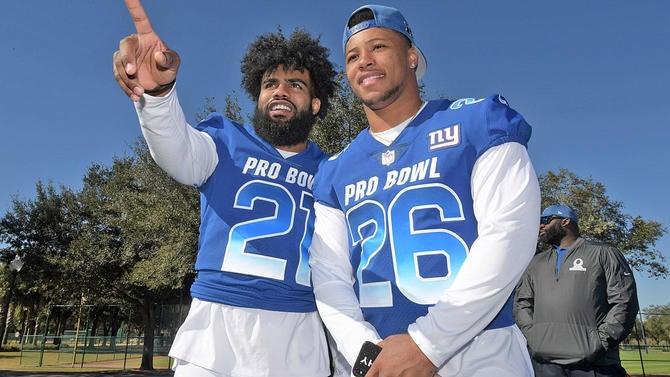
2. NFC East
Cowboys: Ezekiel Elliott, Darius Jackson, Tony Pollard
Eagles: Jordan Howard, Miles Sanders, Corey Clement
Giants: Saquon Barkley, Wayne Gallman
Redskins: Adrian Peterson, Derrius Guice, Chris Thompson, Bryce Love, Samaje Perine
The NFC East might be the most obvious pick for the best division because of Saquon Barkley and Ezekiel Elliott. But while it's true that Barkley and Elliott are two of the best running backs in the NFL, it's also true that the rest of the division doesn't measure up.
The Eagles traded for Jordan Howard this offseason, but that didn't necessarily fix their problem at the position. Howard exploded onto the scene in 2016 and 2017, when he rushed for 2,435 yards while averaging 4.6 yards per carry. But this past season, his production dipped. He rushed for 935 yards while averaging 3.7 yards per carry. The bigger problem is that Howard is a one-dimensional back who can't be expected to contribute as a pass catcher.
Offsetting that problem is Corey Clement, who's caught 32 of 40 targets while averaging 9.8 yards per catch in his career. Second-round rookie Miles Sanders could also play a pivotal role in the offense, especially if Howard struggles to rediscover his form. In short, while the Eagles don't have a star the way the Cowboys and Giants do, they have a committee that could be productive as a collective.
The same goes for the Redskins. We thought Adrian Peterson was done given his age, but he proceeded to rush for 1,042 yards in 2018. Like Howard, Peterson's shortcomings as a pass catcher matter. Peterson was only afforded all of those opportunities because 2018 second-round pick Derrius Guice tore his ACL over the summer. Guice should be back. He'll be joined by Chris Thompson (an all-around weapon if healthy), Samaje Perine (who has been impressive throughout the offseason), and rookie Bryce Love (who could've been a first-round pick a year ago, but is now working his way back from a knee injury). It's not a bad group, but it is imperfect.
The reason the NFC East finished below the AFC North even though it has better top-line individual talent? It's less deep and complete than the AFC North.
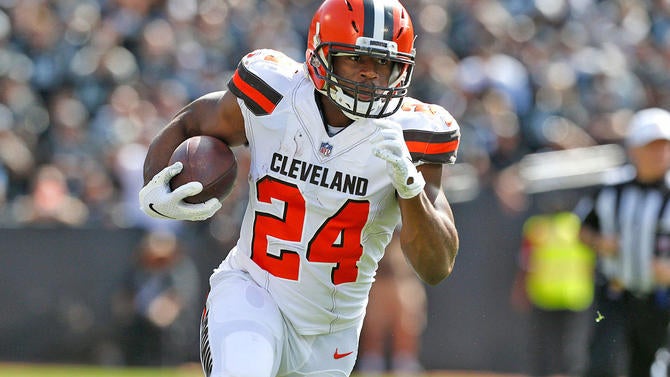
1. AFC North
Bengals: Joe Mixon, Giovani Bernard
Browns: Nick Chubb, Kareem Hunt, Duke Johnson
Ravens: Mark Ingram, Gus Edwards, Justice HIll
Steelers: James Conner, Jaylen Samuels, Benny Snell
While it's lacking the star power that the NFC East boasts, the AFC North features the most balance. All four teams own good-to-great running back situations. All four backfields also have more than one capable running back. Depth matters.
The Browns have the best running back group in the league -- assuming Hunt returns when his eight-game suspension ends, Duke Johnson doesn't get traded, and Nick Chubb picks up where he left off. James Conner has made replacing Le'Veon Bell look easy and Jaylen Samuels proved his worth as a backup last season with 4.6 yards per carry. Joe Mixon, while carrying some injury concerns, has been dynamic when he's been able to play and Giovani Bernard is a solid backup. Finally, there's the Ravens, a team that's built to run the ball. Adding Mark Ingram to a Greg Roman offense can only help. And here's a friendly reminder that Gus Edwards rushed for 718 yards while averaging 5.2 yards per carry last season.
The AFC North doesn't have a running back as good as Elliott or Barkley. But this isn't a ranking of the best running backs. It's about the collective. The Browns have a better overall group of running backs than the Giants and Cowboys. If you put the eight backfields in a draft, I think it'd shake out something like this:
- Browns
- Cowboys
- Giants
- Bengals
- Steelers
- Ravens
- Redskins
- Eagles
That's an average draft position of four for the AFC North and an average draft position of five for the NFC East. It was tight, but the edge belongs to the AFC North.











